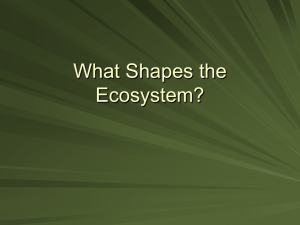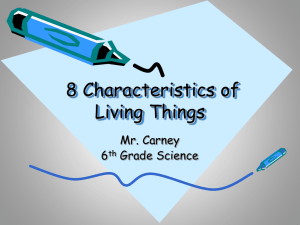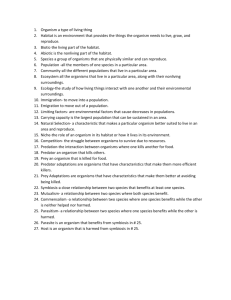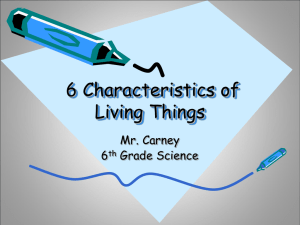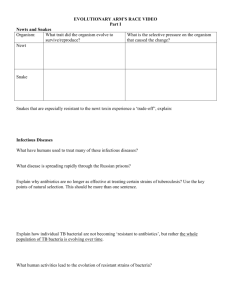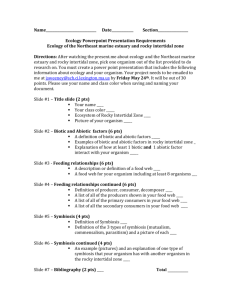Interactions of Living Things Section 1 – Everything is Connected
advertisement
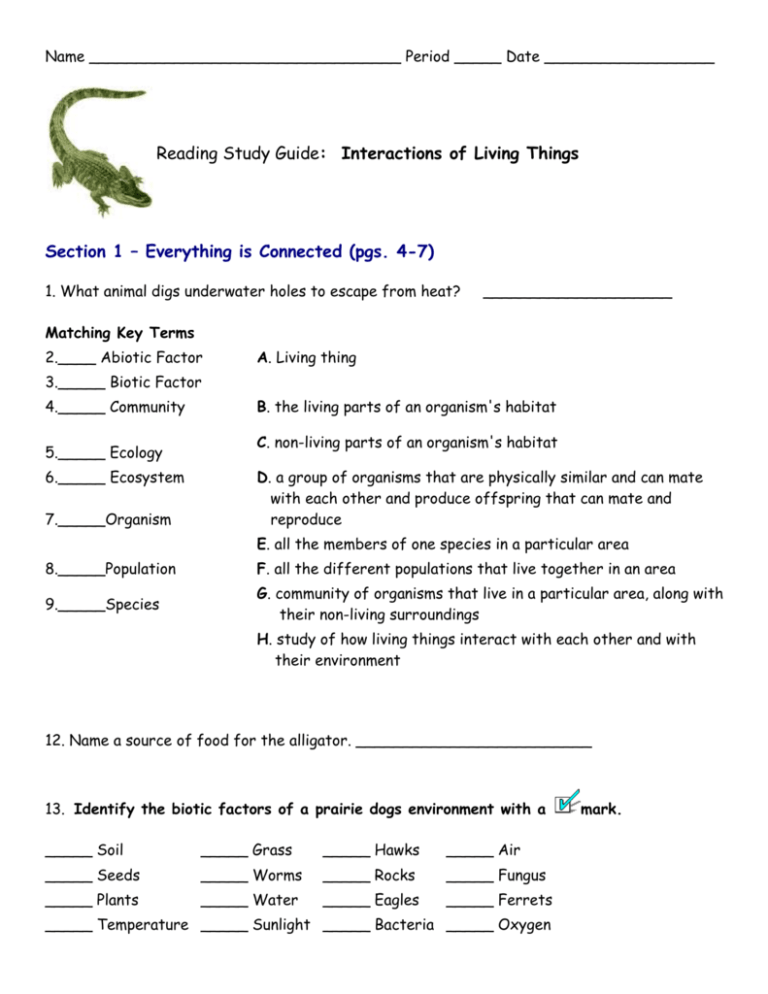
Name _________________________________ Period _____ Date __________________ Reading Study Guide: Interactions of Living Things Section 1 – Everything is Connected (pgs. 4-7) 1. What animal digs underwater holes to escape from heat? ____________________ Matching Key Terms 2.____ Abiotic Factor A. Living thing 3._____ Biotic Factor 4._____ Community 5._____ Ecology 6._____ Ecosystem 7._____Organism B. the living parts of an organism's habitat C. non-living parts of an organism's habitat D. a group of organisms that are physically similar and can mate with each other and produce offspring that can mate and reproduce E. all the members of one species in a particular area 8._____Population F. all the different populations that live together in an area 9._____Species G. community of organisms that live in a particular area, along with their non-living surroundings H. study of how living things interact with each other and with their environment 12. Name a source of food for the alligator. _________________________ 13. Identify the biotic factors of a prairie dogs environment with a _____ Soil _____ Grass _____ Hawks _____ Air _____ Seeds _____ Worms _____ Rocks _____ Fungus _____ Plants _____ Water _____ Eagles _____ Ferrets _____ Temperature _____ Sunlight _____ Bacteria _____ Oxygen mark. 14. List these terms in order from the smallest level to the largest. Population Organism Ecosystem Community Biosphere Smallest _______________ _______________ _______________ _______________ Largest ________________ 15. Look at the picture of the salt marsh on page 6. List 6 biotic factors and 4 abiotic factors. Biotic Factors Abiotic Factors Section 2 – Living Things Need Energy (pgs. 8-13) 1. Where Did Your Dinner Come From? List what you had for dinner last night. Next to each item write the name of the plant or animal that was the source of the food. Example: Macaroni & Cheese Macaroni- wheat Cheese- cow What I ate... Where it came from... Section Vocabulary 2._____ Producer A. consumers that eat only plants 3._____ Consumer B. consumers that eat both plants and animals 4._____ Herbivore C. carnivore that feeds on the bodies of dead organisms 5._____ Carnivore D. a series of events where one organism eats another and obtains energy 6._____ Omnivore E. an organism that makes its own food 7._____ Scavenger F. many overlapping food chains 8._____ Decomposer 9._____ Food Chain 10._____ Food Web 11._____ Energy Pyramid G. a diagram that shows the amount of energy that moves from one feeding level to another in a food web H. obtains energy by feeding on other organisms I. break down wastes and dead organisms and returns the raw materials to the ecosystem J. consumers that eat only animals Energy Connection 12. Name a producer. ____________________________ 13. Name a consumer. ____________________________ 14. Name an omnivore. ____________________________ 15. Name a scavenger. ____________________________ 16. Name a decomposer. __________________________ Food Chains and Food Webs (pgs. 10-11) Create 3 food chains from this food web. 17. --> --> --> --> 18. --> --> --> --> 19. --> --> --> --> Energy Pyramids 20. In an energy pyramid the most energy is found at the _________________ level. Section 3: Types of Interactions (pgs. 14-20) Predation 1. An interaction in which one organism kills and eats another is called _________________. 2. The organism that does the killing is called the ___________________. 3. The organism that is killed is called the _______________. As the population of one species changes, the population of another species that depends on the first species for survival may change as well. Use the graph below to answer questions #4-7. 4. How did the Isle Royale wolf population change between 1977 and 1980? 5. How did the moose population change during that same period? 6. How did the wolf population change between 1986 and 1988? 7. How did the moose population change during that same period? 8-10 Predator Adaptations List the adaptations that help these predators catch and kill their prey. Predator Type of adaptation 11-13 Prey Adaptations Explain how each of these animals displays an adaptation to help them from becoming prey. Prey Defense Strategy 14-16 Symbiosis Symbiosis is a close relationship between two species that benefits at least one of them. Complete the chart that compares the 3 types of symbiosis. Type of Symbiosis Definition Identify each of the following as: Mutualism, Commensalism, Parasitism 17. The red-tailed hawk builds a nest in the saguaro cactus. The cactus is not harmed. This is an example of ______________________ 18. Stinging ants nest in acacia trees. The tree provides the ants' only food. The ants attack other animals that approach the tree. The ants clear competing plants away from the tree. This is an example of _______________________ 19. A vampire bat drinks the blood of horses. The horses can become weak from loss of blood. This is an example of _______________________ Limiting Factors 20. Name 3 limiting factors for populations.



